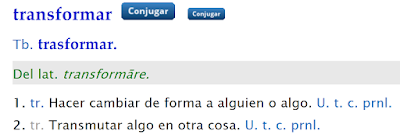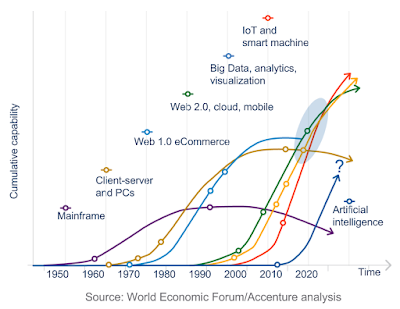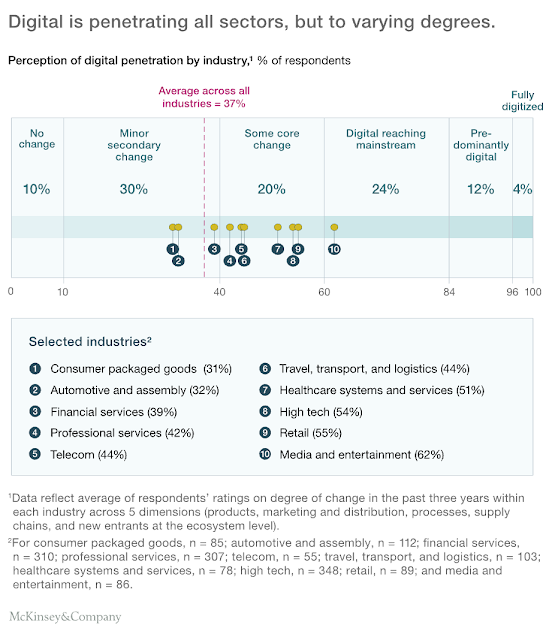What is Digital Transformation?

Digital Transformation is sometimes confused with process digitization, other times with digital marketing, and even sometimes as a tool to justify all kinds of initiatives.
So much so that Digital Transformation has become a term hated by many, including myself at times. Due to its excessive use, it confuses its meaning. In this post, I aim to reflect on the question: what is digital transformation?
Another option, perhaps simpler, would be to forget the term and use a less common one: Digital Business Reinvention.
What is Digital Transformation according to official organizations?
Since we are talking about definitions, let’s start with the words “transformation” or “transform,” what do they mean according to the Royal Spanish Academy (RAE)?:
RAE Definition
The second meaning, “To transmute something into something else,” directly applies.
It is not a superficial change but a profound one. When applied to businesses, it implies a radical change defining new strategies and, perhaps, discarding those that have led the company to its current success.
According to the World Economic Forum, Digital Transformation is:
“how the lower cost and greater access to new technologies are redefining customer expectations; and how companies deliver their products and services. And, as a result of the above, impacting how people live and work.”
The WEF in its “Digital Transformation Initiative” indicates that digital innovation is redefining industries by transforming current business and operational models. It is also having a profound impact on society, presenting a series of opportunities and risks for both businesses and policymakers.
The WEF highlights that the combinatorial effects of technology are accelerating this change and illustrates it in the following graph.
Combinatorial effect of technologies
What is Digital Transformation according to Analysts?
Gartner and its analysts do not usually talk about Digital Transformation in isolation but about Digital Business Transformation and Digital Businesses. For Gartner, a Digital Business starts with the creation of new business models where the physical and digital worlds merge and blur. It promises to introduce an unprecedented convergence of people, businesses, and things that break current business models ” even those born in the Internet and e-business eras. The following diagram summarizes this powerful idea.
Digital Transformation according to Gartner
It may seem like a generic description, but that is where its potential lies. The fusion between the physical and digital worlds has had a significant impact in various sectors such as banking, media, the music industry, private passenger transportation, etc. But it doesn’t stop there. This fusion between both worlds also occurs when instead of buying a car, you decide to book a shared vehicle through an app.
Forrester, in its recent study “Predictions 2018: a year of reckoning,” states that Digital Transformation is not a precision surgery. It is the critical response needed to meet growing customer expectations, offer personalized experiences at scale, and operate at market speed.
Regarding its level of progress, the same study provides the following insight:
- More than 60% of executives believe they are lagging behind in their Digital Transformation
- 20% of CEOs will not act, and their companies will be acquired or begin to perish.
- Talent is key and scarce. Those who are not attractive to it will have to pay 20% above market rates.
McKinsey, in its article “The case of digital reinvention,” incorporates the term reinvention. Probably a clearer way to speak than with the term transformation. McKinsey indicates that digital technology, despite appearing ubiquitous, has only just begun to penetrate industries. As it progresses, the implications for revenue, profits, and opportunities will be dramatic.
McKinsey shows in the following table the level of progress of different sectors in their Digital Transformation process.
Digital Transformation status by sectors according to McKinsey
What is Digital Transformation according to “academia”?
I could highlight various academic definitions, but I will stick with the one from N. Venkat Venkatram, a professor at Boston University, in his book “The Digital Matrix.”
In that book, Professor Venkatram defines Digital Transformation as:
“The process of evaluating and, perhaps, discarding strategies that have been successful in the past industrial era. At the same time, it must identify new ways to win in the digital future.”
In his book, Professor Venkatram also talks about business reinvention, abandoning successful strategies from the past to adopt new ones. He also characterizes a successful Digital Business by three main characteristics:
- Scalability: being able to produce more products or services for more people
- Reach: producing different products or services
- Speed: being able to scale or expand reach faster than the market
These three characteristics differentiate a digital business from a traditional one, so we should focus on them as the goal of every digital transformation. Otherwise, the change will not be as profound as the definition of the word transformation itself suggests.
Conclusions: What is Digital Transformation?
A radical change in businesses facilitated by the combinatorial effect of technologies that merges the physical and digital worlds to meet customer expectations.
Its goal is to achieve the scalability (of products/services to more customers/users), reach (generating a greater variety of products/services), and speed (in scaling growth, reach, or both) necessary for a business’s success in the digital world.
This definition stems from Professor Venkatram’s ambitious vision, although clarifying in its interpretation that not all digital transformations will entail a reinvention of the business but, in many cases, of a part of its processes.
It also focuses on Business rather than technology. A real digital transformation must have an impact on the business that translates into the search for efficiencies or new revenues based on a better understanding of the user.
Technology, along with people (employees), are the tools to achieve change. Of the two, I would highlight the employees. Business transformation is not possible without organizational alignment, which requires cultural and structural changes.
5 BASIC IDEAS ABOUT DIGITAL TRANSFORMATION
I want to highlight 5 basic ideas that every definition of Digital Transformation should include:
- It is a radical change in businesses.
- Facilitated by the combinatorial effect of technologies.
- Merging the physical and digital worlds.
- To meet customer expectations.
- With the goal of achieving the scalability, reach, and speed necessary for a business’s success in the digital world.
All of this with a clear goal of achieving greater efficiency and new sources of income in the long term.
Therefore, it is not enough to add digital aspects to an existing physical business but to digitally reinvent the business by merging both worlds.
Regarding the progress of industries, according to studies, there is much to be done; we have only just begun.
REFERENCES
WEF: Digital Transformation Initiative
FORBES: Digital Business is Everyone’s Business (by Gartner)
FORRESTER: Predictions 2018: A year of reckoning
MCKINSEY: The case for digital transformation
ALABAMA SHAKES
This is my first post of 2018 and, dedicated to those who accuse me of being old-fashioned, an excess with a group from this decade. The Alabama Shakes, a group that “reinvents” southern rock in their first 2 albums (2012 and 2015).
I leave you with the energy of their lead singer and guitarist, Brittany Howard, in the first single (Hold On) from their debut album (Boys & Girls). Enjoy.
Related posts

Digital Transformation: Beyond Technology
In Digital Transformation, purpose and culture are more important than technology itself.

The Human Side of the Digital Revolution
In this post, I want to start a reflection on whether technology brings us closer to a better world or distances us from it. On the International Day for...

Reinvention, Capabilities, and Lagartija Nick
Tonight I resume live shows as I left them, with Lagartija Nick.
All opinions expressed on this blog are personal and do not represent those of any company or organization with which I collaborate.






